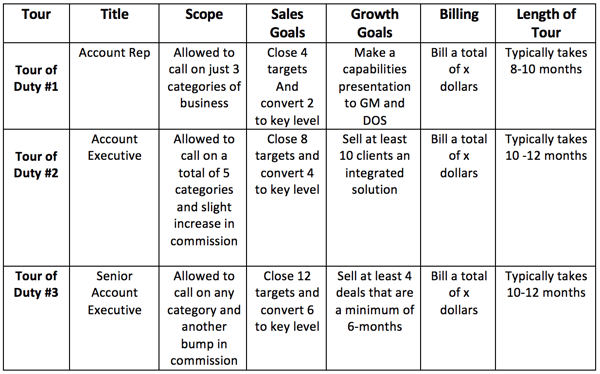 The Tour of Duty Framework
The Tour of Duty Framework
There are so many young people out there with innate talent and tremendous potential… but zero sales experience.
Hiring them can be a risky move. Even though you may initially get them for cheap because they have no proven track record, you’ll need to invest a lot in them in the form of time and training. What if it doesn’t work out? Or what if they are successful and they leave you?
Do you take the chance?
The fact is, people don’t join a company for life anymore. The latest research shows that 33% of employees decide whether they will stay with a company long-term after being on the job for one week or less, and 63% make the decision in the first month!
So, how do we hire great salespeople without experience, coach and invest in them to give them a chance to learn and grow, but do it in a low-risk way for both the seller and the company?
The answer is simple: Bring them on for a Tour of Duty.
The term, “Tour of Duty” is normally used in the context of the military, so you may be wondering, what is a Tour of Duty in the business world?
A Tour of Duty in the business world is an ethical commitment between the company and the employee, outlining a specific mission with a realistic timeline that benefits both. During this mission, the employee promises to fully invest in the company’s success and, at the same time, the company promises to fully invest in the employee’s market value. At the end of the Tour of Duty, both the salesperson and the sales organization will have benefited, and they will each be able to decide whether they want to enlist in another tour.
Here’s what a 12-month Tour of Duty could look like:
Employee mission: Meet annual budget of $400,000 in next 12 months
Company mission: Provide employee with three months of sales training and work with them to develop strong negotiation skills over next 12 months
The employee benefits from the meaningful mission and personal growth, while the company benefits from the low-risk investment in a candidate with great potential.
This is proven to work. Reid Hoffman, founder of LinkedIn, architect of the Tour of Duty concept in business, and author of the book, The Alliance, would tell you that the Tour of Duty framework helped him to “recruit and retain all-star talent at LinkedIn.”
Recruiting and retaining all-star talent is key for a company to grow, and if that company uses a strong talent assessment to identify potential in those without experience, it gives them an edge in the marketplace. The Tour of Duty provides the framework for success.
It also makes a non-issue of what is often an immense worry for hiring managers: What if I invest in them and then they leave? Let’s face it, worrying that this will give people permission to leave once the tour is completed makes no sense. The fact is they don’t need your permission to leave. Employees can leave at any time. The Tour of Duty keeps them from doing it behind your back, and it creates a win-win for both them and for you.
The ultimate goal, of course, is re-enlistment. After the initial Tour of Duty, if both the employee and the company want to consider re-enlistment, another tour can begin. Each tour should provide an increasingly challenging mission.
Here’s what this can look like for a seller completing three Tours of Duty:

Investing in your sales team is vital to see growth and success, and the Tour of Duty concept might just be the direction to take to ensure you are moving toward improving sales performance.



